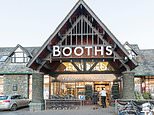
From the Big Four chains like Tesco and Sainsbury’s to budget stores like Aldi, supermarkets have raced to embrace high-tech solutions in recent years.
These range from self-service checkouts to hand-held barcode scanners, in-app payment methods and even digital pricing labels.
But going against the trend is high-end northern chain Booths, much to the delight of many customers.
This week, the business announced it’s ditching self-checkouts and putting staff back behind the tills so shoppers can ‘talk to people’ again.
Although the majority of UK supermarkets are rolling out new tech with rampant enthusiasm, here are the potential signs this year that the more traditional shopping experience may be returning.
To the delight of the traditional shopper, high-end northern chain Booths has just announced it’s ditching self-checkouts and putting staff back behind the tills so customers can ‘talk to people’ again
Many shoppers were glad to hear the news with one calling it ‘wonderful’ that they staff ’embracing the human touch’
SELF-CHEKOUTS AXED
Booths – which has 27 stores in the North across Lancashire, Cumbria, Yorkshire and Cheshire – has been dubbed the northern Waitrose due to its focus on quality.
The company has found self-checkouts to be ‘slow, unreliable and impersonal’ and decided that ‘rather than artificial intelligence, we’re going for actual intelligence’.
It’s taken the decision to remove self-checkouts from all but two of its 28 stores – with the exceptions being in the Lake District at Keswick and Windermere which can become very busy at times.
Many shoppers were glad to hear the news with one calling it ‘wonderful’ that they staff ’embracing the human touch’.
‘It’s wonderful to see Booths stores returning to staffed tills, fostering a more personal and engaging shopping experience,’ said X user @zmilkhan1.
The shift is the first by a UK grocer of a significant size, bucking a trend that has seen all of the major players, including market leaders Tesco and Sainsbury’s, open thousands of self-checkouts and dramatically reduce the amount of staffed checkouts.
According to CBS News, Costco in the US is now adding more staff to in self-checkout areas, although it’s not axing them entirely.
Costco staff has discovered non-members had been sneaking in to use membership cards that didn’t belong to them at self-checkout.
Costco in the US is now adding more staff to in self-checkout areas, although it’s not axing them entirely (file photo)
CARD PAYMENTS RETURN
Although it’s well known for pioneering the use of technology for its physical ‘Fresh’ grocery stores, Amazon has backtracked on its no-card payment rule.
Before, the only way customers could get inside an Amazon Fresh store was to open the Amazon app and get a QR code that they’d scan to open a barrier.
When customers had their groceries and were done shopping, they could just walk back out the barrier.
But following revamps to the UK branches this autumn, Amazon Fresh is now letting customers walk into the shop normally.
A welcoming pair of double doors say ‘Way in’, while there’s also a separate entrance for people who are ‘just browsing’ and what appears to be extra staff at the entrance.
When people are done shopping, they can scan the QR code on the app like before, but they also now have the more traditional option of paying for their groceries with a contactless card.
An Amazon spokesperson said the Fresh experience will ‘continue to evolve with customers’ and the firm will listen to their feedback – suggesting the change was prompted by public demand.
But by preventing anyone without the Amazon app to enter the Fresh stores – including people without smartphones – Amazon may also have been losing out on business.
‘One of the ways we’ve been improving our stores is by offering more ways for customers to pay,’ the spokesperson said.
‘We know customers want choice and recently we’ve been implementing more ways to pay in our stores, including introducing credit card capabilities and more traditional tills where customers can pay for their items.’
Way in: Following revamps to the UK branches this autumn, Amazon Fresh is now letting customers walk into the shop normally
When people are done shopping, they can scan the QR code on the app, but they also now have the more traditional option of paying for their groceries with a contactless card
Amazon Fresh stores still feature cameras and depth-sensors developed with deep-learning artificial-intelligence techniques to monitor what customers pick up and put back on the shelves.
It means the tech knows exactly what each person has taken from the store and how much to charge their payment details, which are stored on the app.
HOME DELIVERY APP ENDS
Bother delivery was able to take a bit longer because it didn’t include perishables
Bother was a British home delivery startup founded in 2020 that focused on the bare essentials that didn’t need refrigerating.
It used AI to ‘learn’ what a customer was running out of and automatically put it in the customer’s in-app basket for their next order.
Bother’s founder and CEO, Douglas Morton, described his mission as ‘saving you and the planet from household shopping’.
But the startup went bust in June and any outstanding deliveries were left unfulfilled, meaning customers affected had to contact their bank for a refund.
Many users were stunned when they checked on their orders to see a message saying that the company had gone into a liquidation process.
DIGITAL LABELS REMOVED
In September, Asda ended the use of electronic shelf labels in one of its stores after just three years, although the firm says it was only a trial.
The high-tech labels – which used hardware developed by Panasonic – quickly updated pricing and allergen information without the fuss of paper labels.
Electronic shelf labels (ESLs) can quickly update pricing and allergen information without the fuss of paper labels
Around 23,000 of them were rolled out at the supermarket giants Stevenage store, although the trial has ‘now come to an end’, Asda confirmed to MailOnline.
‘We will be assessing the results whilst we move our focus onto other live trials and projects,’ a spokesperson said.
Digital labels have proved controversial as they make it easier for supermarkets to suddenly change prices in the blink of an eye, and they can be hard to read.
Bugs also mean the gizmos could blackout and fail to show information, giving human staff an extra thing to contend with.
The supermarket of the future? Sainsbury’s opens its most energy-efficient store in Hampshire with doors on chilled cabinets, 700 solar panels on the roof and floor sensors to optimise natural light
Whether it’s turning off lights when not using them or bringing a reusable water bottle instead of buying a plastic one, many of us try to take measures to reduce our carbon footprint.
Now, Sainsbury’s has opened a new store that even makes your weekly food shop more eco-friendly.
The ‘ground-breaking’ store in Hook, Hampshire, is Sainsbury’s most energy-efficient supermarket yet.
It has several impressive features, including doors on chilled cabinets, 700 solar panels on the roof and even floor sensors that adjust the LED lights in response to natural light.
Read more
Source link
CHECK OUT: Top Travel Destinations
READ MORE: Travel News



